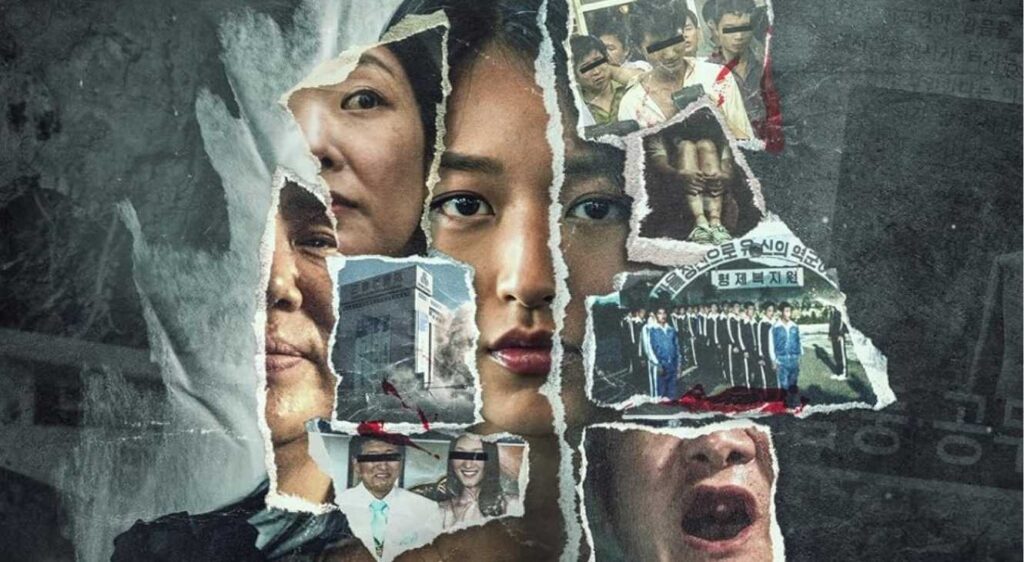The Echoes of Survivors: Inside Korea’s Tragedies is a reminder of how centering a project on tragedy can easily read as exploitative. Documentaries are arguably the hardest things to make in film, requiring balance, thorough research, and the ability to craft a strong story. On top of it all, you need to grab the audience’s attention and spark emotion. One thing is clear after watching The Echoes of Survivors. Emotional responses are guaranteed, but decisions made by director/producer Jo Seong-hyeon and his team leave things on a sour note.
In this eight-episode docu-series, four tragedies are covered, though technically, one of the tragedies featured is a follow-up to In The Name of God: A Holy Betrayal by the same team. Every two episodes cover one specific tragedy, essentially making each tragedy a feature-length viewing. There’s nothing wrong with that, specifically because there is a through line that links all the tragedies together. As we dig deeper into these tragedies, greed emerges and, more often than not, someone powerful is pulling the strings.
However, the order in which the tragedies are presented in the series is odd. Starting with easily the most controversial is The Brothers’ Home episodes, featuring survivors from the internment camp, marketed as a rehabilitation facility. This story is arguably the most difficult to digest. With its non-linear structure of revealing what happened and the obvious subject matter, the stage is set for an uncomfortable watch.
The thing is, the production team goes the extra mile in layering on the discomfort, not just for the viewer but also for those they are interviewing. This is on full display in The Brothers’ Home episodes, where the production team reconstructed parts of the camps, like the barracks where the survivors slept, where the survivors sit during interviews. If that wasn’t bad enough, the survivors spend the bulk of the episodes wearing recreations of the jumpsuits they were forced to wear in the camps.
The Brothers’ Home episodes in The Echoes of Survivors: Inside Korea’s Tragedies raise ethical concerns.

Discussing one’s trauma can be hard enough, but the need to immerse these survivors through these methods is ethically questionable. And, unfortunately, this sets a disconcerting tone early on for The Echoes of Survivors: Inside Korea’s Tragedies. The second episode in The Brothers’ Home section fares a little bit better, though again, a confrontation in the episode featuring Jo Seong-hyeon and one of the victims made me wonder whether or not sufficient protection was put in place for the victim in case things escalated.
These first two episodes set the emotional energy so high in The Echoes of Survivors: Inside Korea’s Tragedies that it almost set up the rest of the series to fall. Typically, in a docu-series focusing on different things, you’d want to build the energy up to a crescendo. By starting things off so sensationally, everything that comes after almost seems like an afterthought.
This leads into Episodes 3-4, which serve as a follow-up to In The Name of God: A Holy Betrayal. These episodes provide some new information surrounding the aftermath of the docu-series release, and how far Jung Myung-seok’s followers would go to protect him, resulting in truly terrifying revelations involving the police. It makes for compelling viewing, no doubt, but some issues arise in viewing.
It would have been more effective as a standalone special, separate from The Echoes of Survivors: Inside Korea’s Tragedies. The reason is that if you haven’t yet watched In The Name of God: A Holy Betrayal, there is a lack of context for the viewer. There is some information given to fill in the blanks, but without that context earlier on, a viewer can easily get lost in trying to figure out what is going on, what the urgency is, etc. While things do end on a high note, it is likely more rewarding as a payoff if you go in knowing what’s going on.
One follow-up segment leaves unfamiliar viewers in the dust, failing to catch them up to speed.

The second half of The Echoes of Survivors: Inside Korea’s Tragedies is arguably calmer despite the emotionally laden subject matter. Whereas the first half of the series featured more pressing urgency, the second half is more settled. There are no chases or interrogations; there is reflection and a somber, settling mood that takes hold after such a rushed high earlier on.
The third tragedy featured in The Echoes of Survivors: Inside Korea’s Tragedies centers around the Chijon family murders and focuses primarily on the lone survivor, Lee Jeong-su. What Jeong-su regales is horrible, and thankfully, Jo Seong-hyeon doesn’t insert himself into the narrative here like he did in previous episodes. This is a story centered around her experience, fleshed out by police officers, archival news footage, and audio of a case that rattled South Korea’s society.
There is more linear regularity here, so the story doesn’t go all over the place like previous episodes. This makes it easier to follow along, but it does slow down the pacing a little bit. Re-enactments of what happened (a feature throughout the series), coupled with Jeong-su’s voice, add an immersive quality typically found in the True Crime genre. Her voice, though, adds an extra layer that’s hard to shake. Even still, despite the subject matter, there is a calm feeling here that almost feels welcoming after a binge.
Archival footage allows us to see a different side not presented in interviews.

Similarly, the final episodes that focus on the Sampoong Department Store collapse reflect this calm. These episodes are thorough and follow that same linear pattern. The range of interview subjects reflects how big an impact this tragedy had at the time, with parents, rescue workers, and survivors coming together to share their perspectives. Arguably, the Sampoong Department Store episodes might have been the strongest ones in The Echoes of Survivors: Inside Korea’s Tragedies because of the many voices that could be heard.
The Echoes of Survivors: Inside Korea’s Tragedies is a little questionable. The survivors of each tragedy are centered, but there are steps taken by the team that cloud whether or not they are being given a place to share their truth or being used. There are several instances throughout the series that gave pause. Thrusting interviewees into reconstructed settings where they experienced their trauma is not a great practice, yet in The Brothers’ Home and Sampoong Department Store episodes, this is done.
Yet, the reality is that, more so for international viewers than Korean viewers, The Echoes of Survivors: Inside Korea’s Tragedies is likely our first time learning about these tragedies. The argument can be made that these reconstructions and other actions are meant to help the viewer imagine what this would look like. However, given the amount of archival footage found and the pictures shown, the argument can also be made that these set pieces didn’t need to be built, that they didn’t need to have participants dress up, etc. Instead, it comes across as exploitative and almost cruel.
All said, no one can deny the production quality of The Echoes of Survivors: Inside Korea’s Tragedies. The editing is slick. The cinematography and usage of colors create a visually pleasing palette that fits well within the genre. You can tell the team behind this is incredibly skilled when putting together the series. Even the shaky cam moments during more confrontational moments are crisp.
The thing is that high production value can only cover up so many sins. The Echoes of Survivors: Inside Korea’s Tragedies is well-produced but suffers from a lack of balance. Had the series reversed the order of its episodes, starting with the Sampoog Department Store episodes and ending with The Brothers’ Home ones, it would have naturally built up the tension and momentum to the very end. Starting on such a high intensity with The Brothers’ Home episodes makes everything that came after have to compete with that emotional high.
Despite wanting to center the survivors and give them a voice, The Echoes of Survivors: Inside Korea’s Tragedies gets in the way of this mission with its choice decision-making.
The Echoes of Survivors: Inside Korea’s Tragedies is streaming exclusively on Netflix.
The Echoes of Survivors: Inside Korea's Tragedies
-
Rating - 5.5/105.5/10
TL;DR
Despite wanting to center the survivors and give them a voice, The Echoes of Survivors: Inside Korea’s Tragedies gets in the way of this mission with its choice decision-making.








